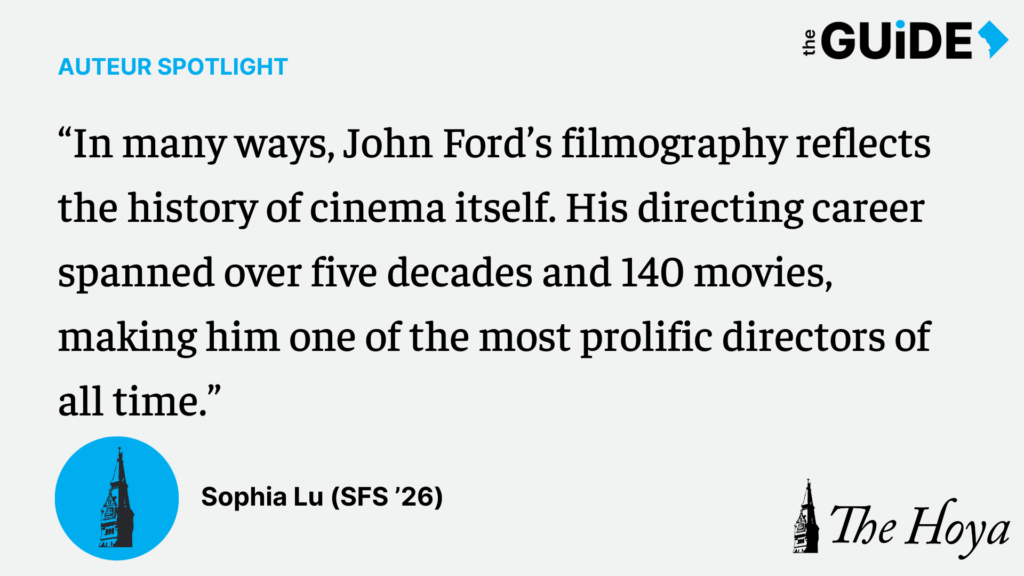If you’re a fan of “Star Wars,” “Raiders of the Lost Ark,” “Goodfellas” or any film hailing from the western genre, you may owe your favorite movie to one of cinema’s original visionaries: John Ford.
The signature John Ford production, “Stagecoach” (1939), opens with a sweeping panoramic sequence of Monument Valley, an icon of the old American West. Over the course of the film, nine passengers on one stagecoach encounter various trials and tribulations brought on by transcontinental travel during the mid-19th century. It is a testament to its lasting brilliance that, even today, “Stagecoach” remains revered by those inside and outside of Hollywood.
In many ways, John Ford’s filmography reflects the history of cinema itself. His directing career spanned over five decades and 140 movies, making him one of the most prolific directors of all time. Not long after the first American motion picture was made in the late 1890s, Ford began directing a wide range of silent films. Some of his earliest include “Straight Shooting” (1917), about a farmer fighting for the right to cultivate his own land, and “The Outcasts of Poker Flat” (1919), adapted from a short story by Bret Harte with the same name. These projects brought a distinctive style of visual storytelling out of Ford, centered around a deep aesthetic commitment to the American frontier, and a penchant for sweeping wide shots that show off the rugged landscapes that so often formed the backdrop of his films.
The late 1920s brought sound to the big screen, to which Ford was quick to adapt. His first feature-length “talkie,” or film with sound, was the adventure epic “The Black Watch” in 1929. Similar to how he prioritized visual storytelling during the silent film era (see: the subtle, unspoken interactions between the farmer and antagonistic ranchers that drive the plot of “Straight Shooting”), Ford continued this practice into the sound film era, except with the additional enhancement of dialogue. These visuals added greatly to character development. For example, the protagonist Captain Donald Gordon King’s internal turmoil is visible and intense, as he attempts to convince his fellow British soldiers that he is a coward, when in reality, Captain King has been assigned a secret mission to rescue captive British soldiers in India.
While Ford’s creative ventures had already attracted a significant amount of attention at the onset of the sound era, his career took off during the Golden Age of Hollywood, which stretched from 1927 to 1969. Reaching true auteur status during this period of time, Ford continued expanding on the visual storytelling that he had cultivated from the start of his career. Other defining characteristics of his directorial style included deep-focus cinematography, a shooting technique that allowed both the foreground and background in shots to be in sharp focus; character-driven narratives; and the exploration of themes of American identity.
Ford cemented his status as the foremost director of Westerns, movies defined by their setting in the American West during the 19th century. Some of my personal favorites from this era include “My Darling Clementine” (1946), a reimagination of the series of events that led to the Gunfight at the O.K. Corral, a famous gunfight from the period, and “How Green Was My Valley” (1941), a semi-autobiographical depiction of a Welsh mining family.
Ford also directed documentaries during World War II under the auspices of the U.S. Navy. He was commissioned as a Navy commander, then assigned to the Office of Strategic Services, where he focused his attention on documenting naval operations. Ford’s filming often took place during real-time combat, allowing him to incorporate significant portions of authentic footage into his documentaries. “The Battle of Midway” (1942) even included shots of aerial dogfights during one of the United States’ decisive victories in the Pacific against Japan.
As a director, Ford’s last project was “Chesty” (1976), a documentary short about a Marine Corps lieutenant general. His career may have ended half a century ago, but Ford’s legacy in the media and entertainment lives on into the modern day. His seminal influence on the Western genre cannot be understated, and neither can his pioneering cinematography experiments like deep focus.
Many of the most revered contemporary filmmakers like George Lucas, Steven Spielberg and Martin Scorsese have all credited Ford as playing a big role in shaping their own creative directions. Ford’s films not only carry substantial cultural and historical significance, but also have immense entertainment value. For your next movie night, I would highly recommend checking out one of his productions.














